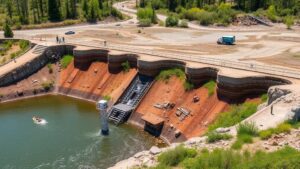Recovering Pottery and Stone Tools in Early River Delta Settlements
Recovering Pottery and Stone Tools in Early River Delta Settlements
Early river delta settlements represent a significant chapter in human history, showcasing the transition from nomadic lifestyles to more sedentary living. The recovery of pottery and stone tools from these sites provides invaluable insights into the daily lives, cultural practices, and technological advancements of early societies. This article examines the methods of recovering these artifacts, their analysis, and the implications for understanding past civilizations.
The Importance of Pottery and Stone Tools
Pottery and stone tools serve as key indicators of technological and cultural development in ancient societies. Pottery, often ornate and utilitarian, reflects aspects of daily life, trade, and artistic expression. Stone tools, on the other hand, are critical for understanding the hunting and gathering strategies employed by these communities.
Research indicates that the advent of pottery occurred approximately 20,000 years ago in East Asia, with evidence of its use spreading globally by around 10,000 years ago. Similarly, stone tool technology dates back to over 2 million years ago, with diverse forms ranging from hand axes to refined blades. Understanding the recovery of these items in river delta environments is fundamental to the study of early human activity.
Techniques for Recovering Artifacts
Recovering pottery and stone tools involves a range of archaeological techniques designed to minimize damage and maximize data recovery. The primary methods include:
- Surface Surveying: Archaeologists often begin with surface surveys, systematically walking over a site to collect visible artifacts. This method addresses the distribution and abundance of materials across the delta landscape.
- Excavation: Stratigraphic excavation is crucial for understanding the chronological context of findings. By carefully removing layers of soil, archaeologists can establish a timeline of human activity and environmental change.
- Geoarchaeology: This interdisciplinary approach combines geological analysis with archaeological data. By studying sediment and landforms, researchers can identify ancient river channels and settlements that may have preserved artifacts.
- Remote Sensing: Techniques such as aerial photography and ground-penetrating radar are employed to detect subsurface structures and deposits without intrusive digging.
These techniques are frequently used in conjunction to create a comprehensive recovery strategy. For example, the archaeological work at Çatalhöyük, Turkey, showcases the effectiveness of layered excavation combined with surface surveys to uncover both pottery and stone tools dating back to 7500 BCE.
Analyzing Artifacts
The analysis of recovered pottery and stone tools contributes to a broader understanding of cultural practices and technological innovations. Pottery analysis involves examining form, decoration, and fabric. Techniques such as thin section petrography allow scholars to classify the clay sources and understand local resource utilization.
In stone tool analysis, typology plays a significant role. Tools are categorized based on their shape, size, and manufacturing technique. For example, the projectile points recovered from Delta sites in the Mississippi River have been classified into various styles, reflecting advancements in hunting technology and strategies.
Statistics from archaeological sites indicate that the diversity of tools increases significantly in well-established river delta settlements compared to transient camps, showcasing a direct correlation between settlement stability and technological sophistication.
Case Studies and Real-World Applications
One notable case study is the excavation at the Yangtze River Delta in China, where researchers uncovered thousands of pottery fragments and over a thousand stone tools, helping to illustrate the transition from hunter-gatherers to agrarian communities around 6000 BCE. This transition is marked by a shift in pottery styles, with lower wares becoming dominant as agricultural practices took root.
Similarly, the Late Archaic period in the Nile Delta produced a wealth of tools and pottery that reveal the social structures of early Egyptian civilizations. These findings have been essential in understanding the rise of centralized power and trade networks in the region.
Implications for Future Research
Continuing research into recovering pottery and stone tools in early river delta settlements opens the door to new insights into human evolution, social organization, and technological development. As techniques advance — particularly through the integration of digital technology and environmental data — future archaeologists will be able to unveil richer narratives from the past.
Also, understanding how climate change affected these settlements can provide valuable lessons for contemporary society. Statistics show that major deltas are among the most vulnerable ecosystems today, making the study of human adaptation in the past particularly relevant.
Actionable Takeaways
- Support archaeological research through initiatives that promote awareness and funding for excavations, particularly in river delta regions.
- Encourage educational programs that focus on the significance of early pottery and stone tool recovery in understanding human history.
- Leverage new technologies in archaeological research to improve recovery methods and enhance various analytical frameworks.
To wrap up, the study of pottery and stone tools recovered from early river delta settlements is vital for understanding the complexities of human development. These artifacts not only provide clues about ancient technologies but also illuminate social dynamics and cultural practices that shaped early civilizations.

